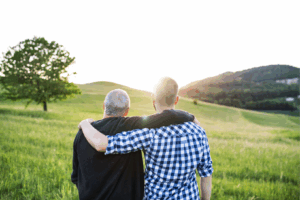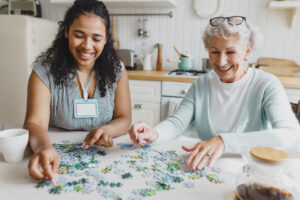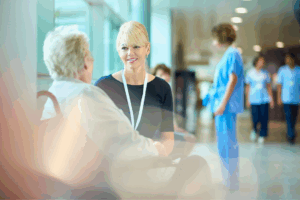Larry had always hated the cold. Every year when winter rolled around he avoided the outdoors as much as possible, opting to stay in his condo with the heat cranked up so he wouldn’t have to feel the damp, penetrating chill of the San Francisco air.
Larry’s tendency to hibernate in the winter became greater as he got older. Eventually, he realized that it wasn’t just the cold that was so hard on him. His lack of physical activity was taking a toll on his body and mind as well.
Larry’s experience isn’t uncommon. Many seniors struggle to stay active throughout the year, but the winter months make it even more difficult. For many, the darker days tend to increase fatigue, the cold can cause arthritic pain to flair, and the rain and snow can keep one indoors, making it harder to engage in movement. Unfortunately, inactivity can have a significant impact on our well being—both physically and mentally. That’s why it is so important for seniors to keep moving all year long.
If your aging loved one has the tendency to be sedentary in the colder months, we’re going to share some of our best tips for how to stay active in the winter as a senior so that they can feel their best all year.
The Importance of Physical Activity for Seniors
At the end of each winter, Larry typically felt weak and drained. He attributed the feeling to the cold weather and the grey skies, but in actuality, his physical symptoms were mostly a consequence of his lack of inactivity. While exercise and movement are important for people of all ages, it is especially important for aging adults.
Engaging in regular physical activity helps aging adults maintain healthy muscle mass and bone density. This is a significant factor in effectively preventing dangerous falls and subsequent fractures or broken bones, making it safer for aging adults to live alone. Regular physical activity can also reduce the risk of cardiovascular disease by lowering blood pressure. And although arthritic pain tends to increase in the winter for many aging adults, exercise can actually help to decrease this pain by lubricating joints.
Of course, the positive effects of physical activity for older adults don’t stop at the physical body. It is well-known that exercise can significantly reduce the symptoms of anxiety, stress, and depression. Furthermore, several studies also confirm that regular exercise can help prevent cognitive decline, making activity all the more important for aging adults susceptible to Alzheimer’s, dementia, and memory loss. In short, the benefits of exercise for older adults are incredible.
Tips for How to Stay Active in the Winter as a Senior
As you can see, aging adults can reap many benefits by engaging in regular physical activity. Unfortunately, the winter does make it tougher to stay active. Whether it’s the icy sidewalk or the persistent rain that is preventing your loved one from getting out and being active, here are some tips for overcoming the obstacles to exercise in the winter:
- Join a gym: Gyms are great places to get some exercise in the winter if it is too chilly outside. Many gyms offer senior discounts on memberships, as well as workout classes specifically for aging adults, like water aerobics or yoga. Encourage your loved one to take advantage of what is available to them. Community and recreation centers often also offer exercise groups for seniors, and they may be less intimidating than the gym. Either way, getting out of the house, staying active, and engaging with other people will inevitably have a positive effect on your loved one’s well-being.
- Exercise at home: While getting out of the house and interacting with others is a great idea, there’s a lot that aging adults can do in the comfort of their own homes when it comes to exercise. Exercises that help older adults improve balance, for instance, often require no equipment and can be done easily on one’s own. It also may be a good idea to get a pair of light free weights for your aging loved one and encourage them to get into the habit of carving out a piece of their day for a little lifting session—they can even do it while they are watching TV!
- Layer up: The winter chill is especially hard for older adults because their bodies generally produce less heat. If they love going for outdoor walks but struggle with the cold, look for a pair of thermal long underwear or a down winter coat to help keep them toasty. You could also suggest that they try drinking a cup of hot tea to warm them up before they go out. Just make sure that your loved one isn’t going outside when it is very icy or slippery.
- Do something fun: Exercise doesn’t always need to be intentional to be effective. There is a whole host of activities for your loved one to engage in that double as fun senior exercises. If your aging loved one loves to garden, help them find an indoor garden or greenhouse to volunteer at a few times a week. Grocery shopping and house cleaning are also great, gentle forms of activity.
While it can be tough to exercise during the winter months, these tips can make it a lot easier for your aging loved one to keep their activity levels up year-round. Of course, always keep safety in mind—if your aging loved one experiences mobility issues, be sure that they always have a family member or caregiver present to supervise them during exercise.
After some encouragement from his daughter, Larry decided to attend weekly Tai Chi classes for seniors at his local community club. Not only did he start feeling much better physically, he noticed that his mood improved as well. Larry even made a few new friends in his class whom he started meeting for coffee on a regular basis. Perhaps winter wasn’t so bad after all.
At Institute on Aging, we strive to make it possible for aging adults to live comfortably, safely, and independently in their homes. For more information on our programs and services, contact us today.







